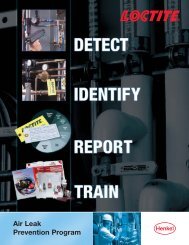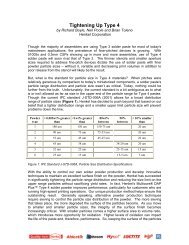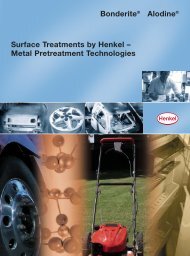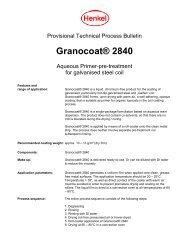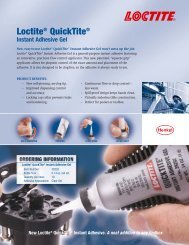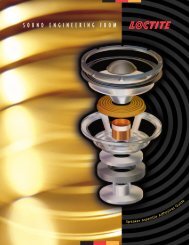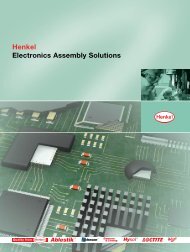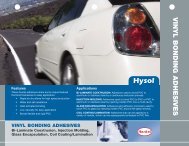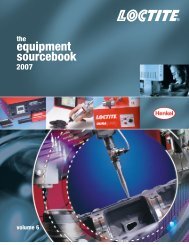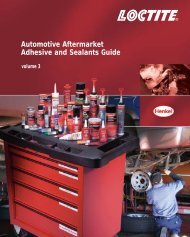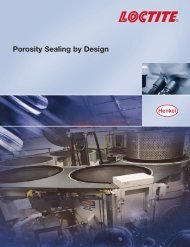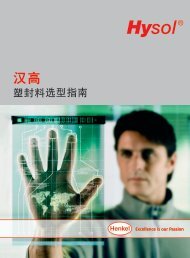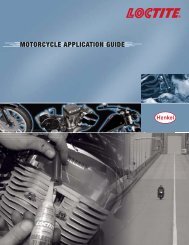Create successful ePaper yourself
Turn your PDF publications into a flip-book with our unique Google optimized e-Paper software.
No-Mix and Static Mix Acrylic AdhesivesGeneral DescriptionAcrylic adhesives consist of a resin and an activator/hardener. The resincomponent is a solvent-free, high-viscosity liquid, typically in the rangeof 10,000 to 100,000 cP, while the activator component can be asolvent dispersion of the cure catalyst (no-mix) or a high viscosity mixof the cure catalyst and performance additives.If the carrier solvent present in the activator solvent dispersion isundesirable, the pure catalyst is also available as a solvent-freeactivator. However, when using a solvent-free activator, the amount ofactivator applied must be tightly controlled, as excessive activator willdetrimentally affect the performance of the adhesive. With static mixacrylics, the viscosity of the resin and hardener are formulated to bevery similar in order to ensure good mixing through the static mix tip.A primer may also be incorporated into the resin or hardener in orderto enhance the bond strength on some substrates.The resin base of no-mix acrylic adhesives can also be heat cured. Atypical heat cure cycle is ten minutes at 300°F (149°C). Heat curingnormally offers higher bond strengths and shorter cure times. However,heating the adhesive lowers the resin’s viscosity and may result insome adhesive flow out of large gaps. In some instances, it is desiredto use a combination of these two cure methods, fixturing the assemblywith activator prior to heat cure.Application MethodWhen an activator is used, the adhesive is cured in thefollowing manner:✓ The resin is applied to one of the substrate surfaces.✓ The activator is typically applied to the other surface.✓ The activator’s carrier solvent is allowed to flash off.✓ The two surfaces are mated together.✓ The catalyst from the activator then initiatesthe polymerization of the resin.Typically, these systems develop fixture strength in two minutes and fullstrength in 4 to 24 hours. The activator serves only as a catalyst for thepolymerization of the resin, so when using an activator, the ratio ofactivator to resin is not critical. However, this is not the case forsolventless activators, because the activator is so concentrated thatexcess activator can prevent the adhesive from forming an intimatebond with the substrate. Since polymerization is initiated at the interfacebetween the activator and resin, the cure depth is limited. Typically, themaximum cure-through-depth is 0.30" (0.76 mm) from this interface.ChemistryThe resin base consists of an elastomer dissolved in acrylicmonomers. Peroxides are then blended in to provide the resin with asource of free radicals. The elastomers form a rubbery <strong>ph</strong>ase whichgives the adhesive its toughness, and the acrylic monomers form thethermoset polymer matrix which gives the adhesive its environmentalresistance and strength.The type of cure catalyst used in the activator will vary depending onthe cure chemistry of the adhesive. In no-mix acrylics, the catalyst(s)are often diluted in a solvent, although in some cases, they aresupplied in solventless formulations. In static mix acrylics, the catalystis blended in with a portion of the elastomer in order to match theviscosity of the resin. Upon contact of the cure catalyst(s) with theresin base, the peroxide in the resin base decomposes to yield freeradicals. These radicals then initiate polymerization through theacrylate groups on the monomer in the resin base.Advantages• No mixing required (no-mix acrylics only)• Good environmental resistance• High peel and impact strength• Bonds to lightly contaminated surfaces• Fast fixture and cure• Room temperature cure• Good adhesion to many substrates• Cure can be accelerated with heatDisadvantages• Higher viscosity systems can make automateddispensing difficult• Activator may contain solvents (no-mix acrylics only)• Unpleasant odor• Limited cure-through depth (no-mix acrylics only)• High exotherm (static mix acrylics)• Short worklife of some formulations (static mix acrylics)Static mix acrylic adhesives are dispersed using hand held applicatorsand the appropriate static mix tip (typically 24 elements). Static mixacrylics offer unlimited depth of cure but due to the exothermic natureof the reaction, caution must be exercised. The exotherm may deformtemperature sensitive substrates or cause “read-through” on theopposite surface.12The <strong>Loctite</strong> ® Design Guide for Bonding Plastics, <strong>Volume</strong> 4



